Buenos Aires, Argentina 作者: 来源: 发布时间:2021-03-23
1. Population and Area
Buenos Aires is the capital and largest city of Argentina. The city is located on the western shore of the estuary of the Río de la Plata, on the South American continent's southeastern coast.
Population (2010 census):2,891,082
Area:203 km2 (78 sq mi)
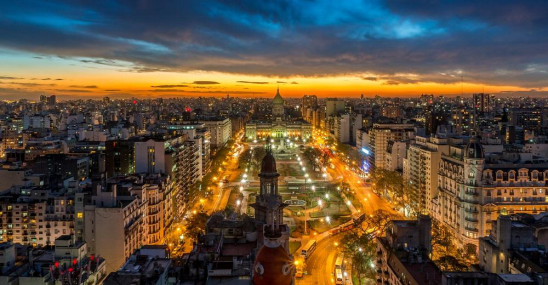
2.Geography
The city of Buenos Aires lies in the pampa region, except for some zones like the Buenos Aires Ecological Reserve, the Boca Juniors (football) Club "sports city", Jorge Newbery Airport, the Puerto Madero neighborhood and the main port itself; these were all built on reclaimed land along the coasts of the Rio de la Plata (the world's widest river).
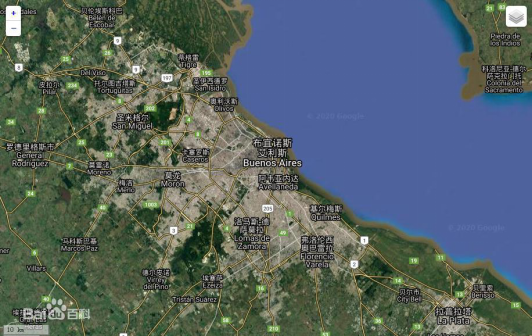
The region was formerly crossed by different streams and lagoons, some of which were refilled and others tubed. Among the most important streams are Maldonado, Vega, Medrano, Cildañez and White. In 1908 many streams were channelled and rectified, as floods were damaging the city's infrastructure. Starting in 1919, most streams were enclosed. Notably, the Maldonado was tubed in 1954, and runs below Juan B. Justo Avenue.
Transport
Buenos Aires is based on a square, rectangular grid pattern, save for natural barriers or the relatively rare developments explicitly designed otherwise (notably, the neighbourhood of Parque Chas). The rectangular grid provides for square blocks named manzanas, with a length of roughly 110 metres (361 feet). Pedestrian zones in the city centre, like Florida Street are partially car-free and always bustling, access provided by bus and the Underground (subte) Line C. Buenos Aires, for the most part, is a very walkable city and the majority of residents in Buenos Aires use public transport.
Two diagonal avenues in the city centre alleviate traffic and provide better access to Plaza de Mayo. Most avenues running into and out of the city centre are one-way and feature six or more lanes, with computer-controlled green waves to speed up traffic outside of peak times.
The city's principal avenues include the 140-metre (459 ft)-wide July 9 Avenue, the over-35 km (22 mi)-long Rivadavia Avenue, and Corrientes Avenue, the main thoroughfare of culture and entertainment.
In the 1940s and 1950s the General Paz Avenue beltway that surrounds the city along its border with Buenos Aires Province, and the freeways leading to the new international airport and to the northern suburbs, heralded a new era for Buenos Aires traffic. Encouraged by pro-automaker policies that were pursued towards the end of the Perón (1955) and Frondizi administrations (1958–62) in particular, auto sales nationally grew from an average of 30,000 during the 1920–57 era to around 250,000 in the 1970s and over 600,000 in 2008.Today, over 1.8 million vehicles (nearly one-fifth of Argentina's total) are registered in Buenos Aires.
Toll motorways opened in the late 1970s by mayor Osvaldo Cacciatore provided fast access to the city centre and are today used by over a million vehicles daily. Cacciatore likewise had financial district streets (roughly one square km in area) closed to private cars during daytime. Most major avenues are, however, gridlocked at peak hours. Following the economic mini-boom of the 1990s, record numbers started commuting by car and congestion increased, as did the time-honored Argentine custom of taking weekends off in the countryside.
3.Economy
Buenos Aires is the financial, industrial, and commercial hub of Argentina. The economy in the city proper alone, measured by Gross Geographic Product (adjusted for purchasing power), totaled US$84.7 billion (US$34,200 per capita) in 2011 and amounts to nearly a quarter of Argentina's as a whole. Metro Buenos Aires, according to one well-quoted study, constitutes the 13th largest economy among the world's cities.The Buenos Aires Human Development Index (0.923 in 1998) is likewise high by international standards.
Port
The port of Buenos Aires is one of the busiest in South America; navigable rivers by way of the Rio de la Plata connect the port to north-east Argentina, Brazil, Uruguay and Paraguay. As a result, it serves as the distribution hub for a vast area of the south-eastern region of the continent. The Port of Buenos Aireshandles over 11 million revenue tons annually,and Dock Sud, just south of the city proper, handles another 17 million metric tons. Tax collection related to the port has caused many political problems in the past, including a conflict in 2008 that led to protests and a strike in the agricultural sector after the government raised export tariffs.
Service
The city's services sector is diversified and well-developed by international standards, and accounts for 76% of its economy (compared to 59% for all of Argentina's). Advertising, in particular, plays a prominent role in the export of services at home and abroad. The financial and real-estate services sector is the largest, however, and contributes to 31% of the city's economy. Finance (about a third of this) in Buenos Aires is especially important to Argentina's banking system, accounting for nearly half the nation's bank deposits and lending.Nearly 300 hotels and another 300 hostels and bed & breakfasts are licensed for tourism, and nearly half the rooms available were in four-star establishments or higher.
Government finances
The city's budget, per Mayor Macri's 2011 proposal, included US$6 billion in revenues and US$6.3 billion in expenditures. The city relies on local income and capital gains taxes for 61% of its revenues, while federal revenue sharing contributes 11%, property taxes, 9%, and vehicle taxes, 6%. Other revenues include user fees, fines and gambling duties. The city devotes 26% of its budget to education, 22% for health, 17% for public services and infrastructure, 16% for social welfare and culture, 12% in administrative costs and 4% for law enforcement. Buenos Aires maintains low debt levels and its service requires less than 3% of the budget.
4. Industry
Manufacturing is, nevertheless, still prominent in the city's economy (16%) and, concentrated mainly in the southern part of the city. It benefits as much from high local purchasing power and a large local supply of skilled labor as it does from its relationship to massive agriculture and industry just outside the city limits. Construction activity in Buenos Aires has historically been among the most accurate indicators of national economic fortunes, and since 2006 around 3 million square metres (32 million square feet) of construction has been authorized annually. Meat, dairy, grain, tobacco, wool and leather products are processed or manufactured in the Buenos Aires metro area. Other leading industries are automobile manufacturing, oil refining, metalworking, machine building and the production of textiles, chemicals, clothing and beverages.
5. Landmarks
Cabildo was used as the government house during the colonial times of the Viceroyalty of the River Plate. The original building was finished in 1610 but was soon found to be too small and had to be expanded. Over the years many changes have been made. In 1940, the architect Mario Buschiazzo reconstructed the colonial features of the Cabildo using various original documents.
Kavanagh building is located at 1065 Florida St. in the barrio of Retiro, overlooking Plaza San Martín. It was constructed in the 1930s in the Rationalist style, by the architects Gregorio Sánchez, Ernesto Lagos and Luis María de la Torre and was finished in 1936. The building is characterised by the austerity of its lines, the lack of external ornamentation and its large prismatic volumes. It was declared a national historical monument in 1999, and is one of the most impressive architectural masterpieces of Buenos Aires. Standing at a height of 120 m, it still retains its impact against the modern skyline of the city. In 1939 its façade received an award from the American Institute of Architects.
Metropolitan Cathedral is the main Catholic church in Buenos Aires. It is located in the city centre, overlooking Plaza de Mayo, on the corner of San Martín and Rivadavia streets, in the San Nicolás neighbourhood. It is the mother church of the Archdiocese of Buenos Aires.
National Library is the largest library in Argentina and one of the most important in the Americas.
The Obelisk was built in May 1936 to commemorate the 400th anniversary of the first founding of the city. It is located in the center of the Plaza de la República (Republic Square), the spot where the Argentine flag was flown for the first time in Buenos Aires, at the intersection of Nueve de Julio and Corrientes avenues. Its total height is 67 meters (220 feet) and its base area is 49 square meters (530 square feet). It was designed by architect Alberto Prebisch, and its construction took barely four weeks.
The Water Company Palace (perhaps the world's most ornate water pumping station)
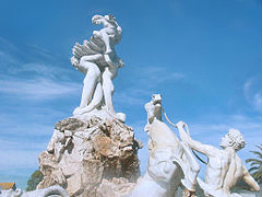
Las Nereidas font by Lola Mora
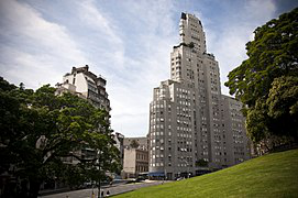
Kavanagh building
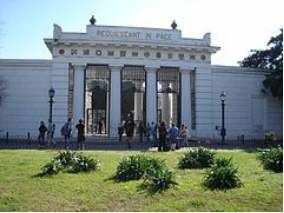
La Recoleta Cemetery
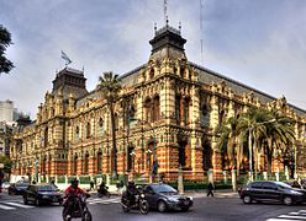
The Water Company Palace
Buenos Aires has over 250 parks and green spaces, the largest concentration of which are on the city's eastern side in the Puerto Madero, Recoleta, Palermo and Belgrano neighbourhoods. Some of the most important are:
Parque Tres de Febrero, designed by urbanist Jordán Czeslaw Wysocki and architect Julio Dormal, the park was inaugurated on 11 November 1875. The dramatic economic growth of Buenos Aires afterwards helped to lead to its transfer to the municipal domain in 1888, whereby French Argentineurbanist Carlos Thays was commissioned to expand and further beautify the park, between 1892 and 1912. Thays designed the Zoological Gardens, the Botanical Gardens, the adjoining Plaza Italia and the Rose Garden.
Botanical Gardens, designed by French architect and landscape designer Carlos Thays, the garden was inaugurated on 7 September 1898. Thays and his family lived in an English style mansion, located within the gardens, between 1892 and 1898, when he served as director of parks and walks in the city. The mansion, built in 1881, is currently the main building of the complex.
Buenos Aires Japanese Gardens Is the largest of its type in the World, outside Japan. Completed in 1967, the gardens were inaugurated on occasion of a State visit to Argentina by Crown Prince Akihito and Princess Michiko of Japan.
Plaza de Mayo Since being the scene of 25 May 1810 revolution that led to independence, the plaza has been a hub of political life in Argentina.
Plaza San Martín is a park located in the Retiro neighbourhood of the city. Situated at the northern end of pedestrianized Florida Street, the park is bounded by Libertador Ave. (N), Maipú St. (W), Santa Fe Avenue (S), and Leandro Alem Av. (E).
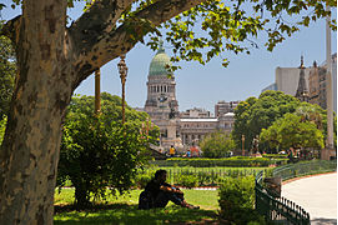
Congressional Plaza
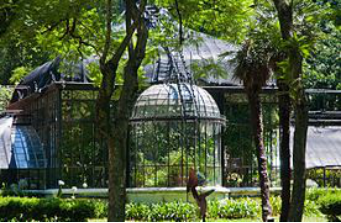
Buenos Aires Botanical Garden
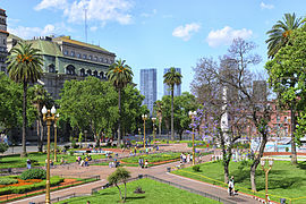
Plaza de Mayo
6. Culture
Strongly influenced by European culture, Buenos Aires is sometimes referred to as the "Paris of South America". The city has the busiest live theatre industry in Latin America, with scores of theaters and productions. In fact, every weekend, there are about 300 active theatres with plays, a number that places the city as 1st worldwide, more than either London, New York or Paris, cultural Meccas in themselves. The number of cultural festivals with more than 10 sites and 5 years of existence also places the city as 2nd worldwide, after Edinburgh. The Kirchner Cultural Centre located in Buenos Aires, is the largest of Latin America, and the third worldwide.
Buenos Aires is the home of the Teatro Colón, an internationally rated opera house.There are several symphony orchestras and choral societies. The city has numerous museums related to history, fine arts, modern arts, decorative arts, popular arts, sacred art, arts and crafts, theatre and popular music, as well as the preserved homes of noted art collectors, writers, composers and artists. The city is home to hundreds of bookstores, public libraries and cultural associations (it is sometimes called "the city of books"), as well as the largest concentration of active theatres in Latin America. It has a zoo and botanical garden, a large number of landscaped parks and squares, as well as churches and places of worship of many denominations, many of which are architecturally noteworthy.
The city has been a member of the UNESCO Creative Cities Network after it was named "City of Design" in 2005.
7.Other information
Buenos Aires' quality of life was ranked 91st in the world in 2018, being one of the best in Latin America. In 2012, it was the most visited city in South America, and the second-most visited city of Latin America (behind Mexico City).
It is known for its preserved Eclectic European architecture and rich cultural life.Buenos Aires held the 1st Pan American Games in 1951 and was the site of two venues in the 1978 FIFA World Cup. Most recently, Buenos Aires hosted the 2018 Summer Youth Olympics and the 2018 G20 summit.
8. Contact Information
Address : Buenos Aires, Uspallata 3150, C1437JCL Buenos Aires
Tel: 54 800-999-2727
Facebook: Gobierno de la Ciudad de Buenos Aires
Website: buenosaires.gob.ar
Chief of Government: Horacio Rodríguez Larreta
